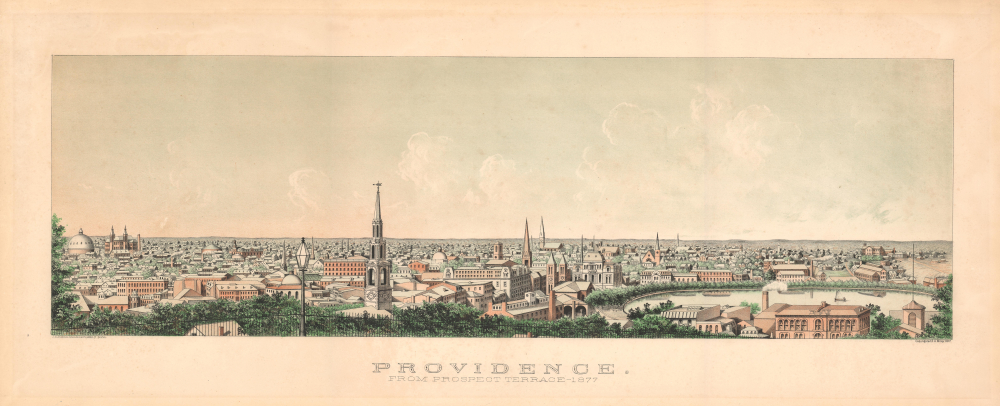1877 Miller / Bufford Bird's Eye View of Providence, Rhode Island
Providence-miller-1877
Title
1877 (dated) 13 x 32 in (33.02 x 81.28 cm)
Description
A Closer Look
This view is oriented towards the west, looking out over the city, as the title indicates, from Prospect Terrace. It is a somewhat early example of a chromolithographic city view, employing three colors (stones) and tinting to produce a realistic image. It is also notable for presenting a lower angle than most bird's-eye city views of the era, which were often sketched from a balloon or imagined from a high angle. As a whole, the view displays some impressive technical precision in the crisp lines of some of the buildings and the fence in the foreground, and the reflection of buildings off the water at right.Several recognizable buildings of the era can be identified. The white tower in the left foreground is the First Baptist Church in America (1774), home to the congregation started by Roger Williams in 1636. Union Station (now the site of Providence's Amtrak Station) is in the foreground near center. To its right is a reservoir near the site of the current State House, completed in 1901. The large building at left is likely the original Rhode Island Hospital.
Many other churches, civic buildings, and commercial buildings (especially just to the left of Union Station) are also illustrated. Providence was undergoing significant changes at this time, as industrialization and immigration reshaped the cityscape (the population more than tripled between 1865 and 1900). In the process, many of the buildings seen here were demolished, and even the layout of the downtown portion of the city was altered to accommodate modern infrastructure.
Prospect Terrace
Known as the 'Jewel of the City,' Prospect Terrace has been one of the primary scenic observation points in Providence since it was given to the city by a group of local residents in 1867. The park is situated in the city's important and affluent College Hill neighborhood, so named because of the topography and its proximity to several institutions of higher education, including Brown University and the Rhode Island School of Design (founded the same year as this view's publication). Among other features, the park is known for a large granite statue of Roger Williams, founder of Providence and Rhode Island, gazing out over the city (after the statue was dedicated in 1939, having been financed by the Works Progress Administration, Williams' remains were relocated to be buried underneath it).Chromolithography
Chromolithography, sometimes called oleography, is a color lithographic technique developed in the mid-19th century. The process involved using multiple lithographic stones, one for each color, to yield a rich composite effect. Oftentimes, the process would start with a black basecoat upon which subsequent colors were layered. Some chromolithographs used 30 or more separate lithographic stones to achieve the desired product. Chromolithograph color could also be effectively blended for even more dramatic results. The process became extremely popular in the late 19th and early 20th centuries when it emerged as the dominant method of color printing. The vivid color chromolithography produced made it exceptionally effective for advertising and propaganda imagery.Publication History and Census
This view was copyrighted to, and likely originally drawn, by G. A. Miller and printed by J. H. Bufford's Sons in 1877. We have been unable to find any specific information on Miller; the most prominent G. A. Miller in New England at the time was a piano manufacturer in Boston. In any event, this view is quite rare, only being noted among the holdings of the Boston Athenaeum, the American Antiquarian Society, and the Amon Carter Museum for American Art. The Rhode Island Historical Society holds an original watercolor, presumably by Miller, which was the basis for the lithograph.Cartographer
John Henry Bufford (July 27, 1810 - October 8, 1870) was a Boston based lithographer and printer. Bufford was born in Portsmouth, New Hampshire. He apprenticed as an artist and lithographer at Pendleton Lithography (1825 - 1836) of Boston. In 1835 he relocated to New York where he took independent commissions from George Endicott and Nathaniel Currier, among others. Returning to his hometown of Boston in 1839, he took a position of chief artist with the firm of Benjamin W. Thayer, heir to Pendleton Lithography. He probably married Thayer's sister, Anna Melora Tufts Thayer (1808-1878). Bufford has been highly criticized as an engraver, with one historian, David Tatham, stating he had 'a mediocre sort of craftsmanship at best' and 'no very special skills as an original artist.' We, however, find no justification for this harsh criticism. Instead Bufford gravitated toward business and management. By 1844 Thayer's shop was renamed J. H. Bufford and Company. The firm specialized in decorative sheet music, panoramic views, illustrations for books, retractions of paintings, and commercial printing. Bufford is credited with being one of the first employers and mentors of the important artist and engraver Winslow Homer. Bufford died in 1870, passing on the business to his sons Frank G. Bufford and John Henry Bufford Jr. These young men, operating under the imprint of 'J.H. Bufford's Sons, Manufacturing Publishers of Novelties in Fine Arts', expanded the firm with offices in New York and Chicago. A possibly related lithographic printing firm named Bufford Chandler was incorporated in Boston in 1893. It later relocated to Concord, New Hampshire but closed in 1925 when its state business charter was repealed. More by this mapmaker...

